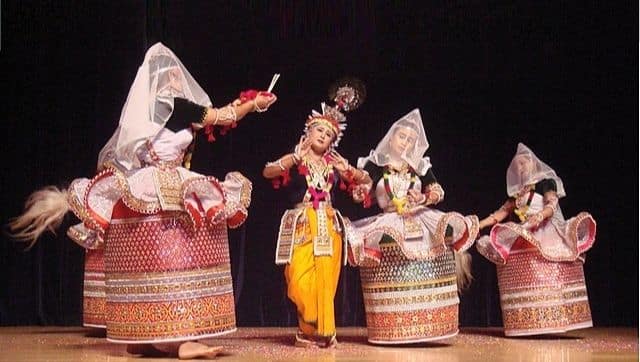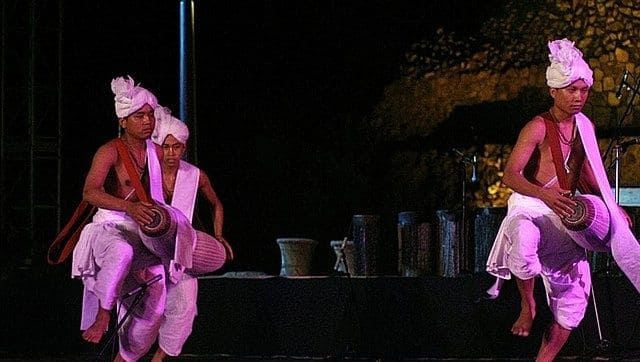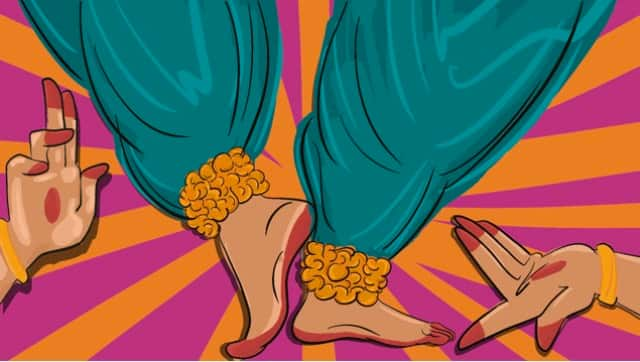Indian classical dances – celebrated across the globe for their enriching and mesmerising virtuosity – can be traced back to centuries-old ways of storytelling, performed as much for entertainment as for the spread of cultures and knowledge. Each classical form is built upon layers of complex histories that often converge at the intersection of culture, art, politics and even conflict, readjusting its structures and boundaries in the light of revolution and reform. Consequently, varying styles of the art form find new homes and families to become gharanas, yet other dance forms are added to the ever-dynamic definition of what constitutes as classical. This series is an attempt to reacquaint the connoisseur and engage the uninitiated in the vibrant facets of the eight classical dance forms of India by offering a glimpse into the history, performance, attire, comportment and musical accompaniments that give colour, form and rhythm to these cultural legacies. In the fourth essay, revelling in Manipuri’s celebration of the Raas Leela. * Manipuri, with origins in age-old folk dance practices, is perhaps the only Indian classical dance that, despite centuries of turmoil and political upheavals, has continued to retain the fullest flavour of its vibrant artistic style in its continued expression of the joyous, transcendental, and even subversive love between Radha and Krishna. Hailing from the Northeastern state of Manipur, the dance is hardly anachronistic but in its modern representation, Manipuri exponents in effect have preserved a rather rich and relatively unexplored repository of compositions that regale audiences with festive exhibitions of the Raas Leela [the dance of Krishna and the gopis of Vrindavan], steeped at once in love and devotion. In Manipuri, these celebrations transpire against the backdrop of the transformations occurring in the natural world: the changing seasons and their hypnotic effect on the very expression of love. One of the eight classical dance forms of India, as identified by the Sangeet Natak Akademi, it is undoubtedly a classical style known for being so utterly attuned to climatic shifts that its most well-known performances, the Basant Raas Leela portrays the love that blossoms between Krishna and Radha in spring – much like the flowers that start to bloom in secluded valleys, and on unblemished mountain slopes after a harsh winter. In its contemporary practice, Manipuri has endured as a dance form which dives deep into such expressions of the shringara rasa [emotion of love] inclined towards the lasya anga or a soft movement vocabulary that becomes an effective medium for depicting the delights of the Raas Leela. The dance form, however, boasts of a very versatile repertoire that does incorporate the more rigorous, tandav elements in its practice of the Thang-Ta, a martial dance performed by male artists or the Sankirtana, the singing and rhythms that accompany the lasya. Origins and history While Manipuri adheres to Bharat Muni’s Natya Shastra in its formalised classical structure, it can nonetheless be traced to the ancient period when the dance was simply a part of the Meitei community’s cultural practice. With roots in Jagoi, it was performed within temple precincts in Imphal and the areas abutting this region to celebrate the Lai Haraoba festival that marks the dancing of the Gods. It was a form of worship directed towards the powers of Shiva and Shakti, and their cosmic dance, brought to earth through the duet recitals of priests and priestesses who sought to seek communion with the divine. Little evidence remains to corroborate this ancient practice but the spirituality embedded within the recitals remains integral to the performance practice of Manipuri, passed down as oral histories through centuries. Gradually, the migration of Brahmins and Buddhists into Manipur, circa 15th century, introduced Vaishnavism, or the worship of Lord Vishnu in this region. Three centuries later, the text Bamon Khunthok not only elucidated these changing patterns but also described how in 1704, the Manipuri monarch King Charai Rongba declared this sect’s devotional practice to be state religion. [caption id=“attachment_10438131” align=“alignnone” width=“640”]  Manipuri Raas Leela[/caption] Amidst these transformations, Manipuri dance too stretched its contours to introduce within its repertoire the Raas leela, along with compositions that continued to sing of Shiva, and simultaneously codified and refined its performance style. It was the Meitei monarch, King Bhagya Chandra who for the first time adopted Gaudiya Vaishnavism or the worship of Krishna [an avatar of Vishnu], and subsequently composed the very first Raas Leelas to effective give Manipuri its present structure. However, the contemporary revival of the dance form, particularly during the British Raj – a time when most indigenous dance forms came under attack – can be attributed to Nobel Laureate Rabindranath Tagore, who is believed to have witnessed a Raas Leela in Sylhet [now in Bangladesh]. So fascinated was the polymath with this art form that he invited the imminent Manipuri artiste Guru Budhimantra Singh to impart his knowledge of the dance to the students at Shantiniketan. The nationalist movement that thus resisted the curtailment of Indian arts fortified a new space in 20th century India for this Northeastern dance form even as it was steadily moving away from temple precincts and royal patronage. In doing so, Manipuri nonetheless sustained its exploration of love – both romantic and spiritual – as well as of bhakti or devotion, that together make-up much of the structure of the art form. Love and spirituality in Manipuri’s abhinaya The soulful and merry rendering of the Raas Leela in Manipuri was performed historically on full-moon nights by a group of female artists. In its present structure, the dance continues to adhere to a similar presentation, where traditionally the Basant Raas Leela is performed around Holi, while others like the Nitya Raas, Kunja Raas, and the Maha Raas are compositions that mark the post-harvest season, Diwali, and the onset of winters. The only exception is the Diba Raas, traditionally presented, as its name suggests, during the day. However, where Manipuri stands out most is in its attention to the characters portrayed in each of these acts. Most often, it is a dance comprising of Radha and Krishna, and the gopis surrounding them namely Sudevi, Indurekha, Lalita, Rangadevi, and Chitra among others. Not only does the dance form set out to showcase Krishna in his various colours of love, mischief, playfulness, and joy through his separation and reunion with the gopis but also explores the anxieties and predicaments of the gopis themselves through its study of the nayika, or the heroine and her quest to unite with her prana sakha [soulmate]. Embedded within her conundrums are multiple facets of abhinaya, particularly in the depictions of the ashtanayika [eight shades of a heroine]. In Manipuri’s repertoire, a connoisseur can discern eight sub-divisions within every nayika, unique to her angst. Seasons and natural rhythms play a crucial role in such vignettes too, so that the adventures of the kuaasha abhisarika, who steps out on a foggy, murky evening into the forest to meet her lover are quite different from the perils of the varsha abhisarika, who braves clapping thunder and heavy downpour to walk treacherous, slippery paths towards her beloved. It is through these practices that Manipuri brings forth more the subversive aspects of its repertoire at once challenging restrictive societal norms, and portraying a romance between the gopis and Krishna that transcends the stringent conceptualisations of marriage and kinship. Particular to Manipuri’s performance practice is also the emphasis on invoking this poignant abhinaya using bodily movements instead of facial expressions. To a Manipuri danseuse, the primary component of a performance continues to be rooted in worship so that with a straight torso and erect knees, the artist stands tall, albeit with a lowered gaze bowing down to the divine at all times. Such a performer then takes upon herself the remarkable task of expressing emotions using angik abhinaya or the rhythmic swaying of the body, with only subtle changes to facial expressions, thereby showcasing her bhakti for the omnipresent divinity. Evidently, there are very few nritta or technical elements in a Manipuri performance, and even as it is now presented by soloists, these hastaka called the pareng are almost always part of the Raas Leela, and are performed in between two abhinaya sequences to the rhythms of musical accompaniments. Costumes and musical accompaniments Because Manipuri is inextricably linked to the life and lore of Krishna, much of its lyrical poetry is composed in the Brij Bhasha [the language of Krishna’s village] or Sanskrit and Maithili. Most often than not however, Manipuri is recognised for its use of Jayadeva’s ashtapadi composed in his Geeta Govindam – these are poems with eight verses that create a delightful imagery of Krishna’s bucolic life in Vrindavan. Along with Jayadeva, other poets like Govindadas and Vidyapati are also among those whose lyrical odes have continued to be a part of Manipuri’s repository. To depict this colourful Krishna, a dancer dresses herself in a bright coloured dhoti along with a peacock feather that adorns her forehead. For their part, the gopis are dressed in a costume typical to Manipuri that consists of a stiff long skirt, shaped like a barrel and embellished with small mirrors and thick floral borders. Affixed to the skirt, called the kumil, is a silky, translucent fabric tied around the waist that opens up like a flower. A choli or velvet blouse is paired with this skirt and the dress is finished off with a white, transparent veil. What sets Manipuri apart are also the dancers’ feet, that completely covered by the skirt, are devoid of the belled anklets or ghungroos worn in most classical dances. The soft movements of the dancers have little to no tatkaar [footwork], and instead they glide across the performance hall to the tunes of instruments like cymbals, flute, and the pena, a Manipuri string instrument. A Raas Leela is usually preceded by a Sankirtana, in which male artists take up the Pung Cholam [a drum resembling the mridangam], and play the Kartal Cholum [similar to cymbals] to invoke the bhakti bhava central to Manipuri. [caption id=“attachment_10438151” align=“alignnone” width=“640”]  Pung Cholam[/caption] The Pung Cholam consists of jumps and acrobatics performed while playing the drum, as does the Kartal Cholum that involves moving in circular, rhythmic patterns to the sounds of the cymbals. Sometimes, female artists also perform the Mandilla Cholam, playing cymbals tied with colourful strings. Within Manipuri Raas Leela is thus encompassed a whole culture, of worship and love, of a musicality, spirituality, and artistic endeavour particular to this region that its stalwarts like Bimbavati Devi or Charu Suja Mathur continue to interpret, reimagine, and make relevant through their contemporary choreography and performance technique. Read more from the Know Your Classical Dances series here. [caption id=“attachment_10383621” align=“alignnone” width=“640”]  Know Your Classical Dances. Illustration by Poorti Purohit[/caption] Aishwarya Sahasrabudhe writes about art, culture, books, and entertainment. Currently, she has returned to school to study the intersections between gender, culture, and development. The writer is a Kathak Visharad practicing and performing the classical dance form for over a decade. Read all the Latest News , Trending News , Cricket News , Bollywood News , India News and Entertainment News here. Follow us on Facebook, Twitter and Instagram.
Not only does the dance form set out to showcase Krishna in his various colours, but also explores the anxieties and predicaments of the gopis through its study of the nayika, or the heroine and her quest to unite with her prana sakha [soulmate].
Advertisement
End of Article


)
)
)
)
)
)
)
)
)



